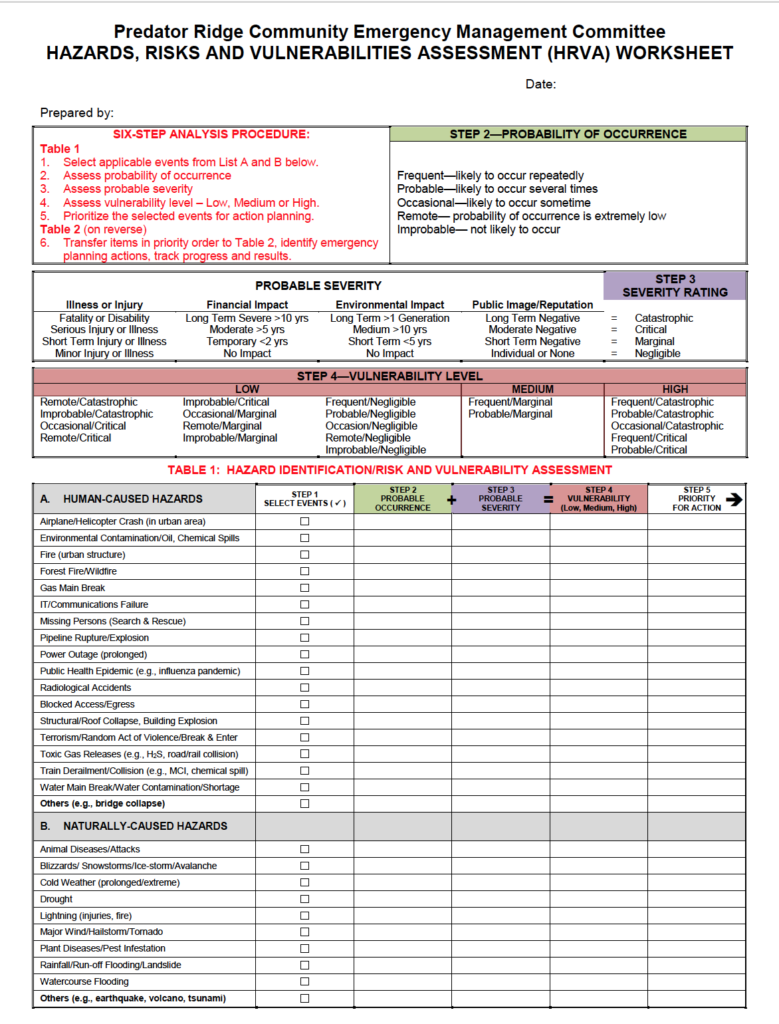What is an HRVA (Why and How Does the PRCEMC Use It?)

HRVA is the acronym for Hazard, Risk and Vulnerability Assessment. It provides the foundation within a continuous emergency planning cycle needed to maintain an effective emergency plan.
It comes from evolving national and international standards in the field of emergency management. The sample HRVA (see link below) may seem complicated, but in practice, it simply involves any person or group following the six-step procedure as outlined on the worksheet:
Step #1:
Select the emergency events from Lists A and B that you feel could possibly have application for your emergency plan. Only omit those you’re certain don’t have application (e.g., a tsunami would not apply if you are not near an ocean).
Step #2:
Assess the “probability of occurrence” (based on a projected timeline and available historical data and current expertise), which will result in a rating of Frequent, Probable, Occasional, Remote or Improbable.
Step #3:
Determine the “probable severity of damage” if the emergency took place, which will result in a rating of Catastrophic, Critical, Marginal or Negligible.
Step#4:
Determine the “vulnerability level” by finding the combination of ratings you gave in Steps 2 and 3, and noting the vulnerability of Low, Medium or High.
Step #5:
Prioritize the vulnerability levels from highest to lowest (If you don’t have any High vulnerability events, then start your list with the Medium and Low events).
Step #6:
In sequential order (1st, 2nd, 3rd), transfer the list from Step 5 so that resources and priority of actions can be identified, allocated, and tracked in accordance with the proactive: Prevention/Mitigation, Preparedness, and the reactive: Response and Recovery components of emergency management.
This emergency planning tool is a good visionary
approach, but is not without its faults. Users can fall victim to subjectivity
as they attempt to assess vulnerabilities objectively. Success depends greatly
on the effort and open-mindedness of those who choose to use it. It can be used
effectively to determine reasonable allocation of resources, and as a
continuous process to ensure that necessary actions are being taken to maintain
an effective emergency plan.
An HRVA can also be used for various non-emergency events (e.g., wedding, vacation, reunion) to help plan for and carry out planning activities.
Since its inception in 2014, the PRCEMC has used this HRVA process, and continues to review and update its content on an annual basis. As you may expect, events such as Wildfire, Medical Emergencies, Break/Enter/Theft and Vandalism, Animal Encounters, as well as Missing Persons and other hazards, continue to be identified and addressed within our HRVA.
Our latest review in the 3rd quarter of 2020 identified the following top 5 priorities for action:
- Forest Fire/Wildfire
- Criminal Activity
- Lightning (injuries, fire)
- Blocked Access/Egress
- Missing Persons
Feel free to contact the PRCEMC if you wish to discuss the use of the HRVA further.


